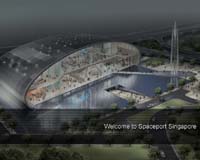| . |  |
. |
Columbus OH (SPX) Feb 21, 2006 On February 20, 1962, John H. Glenn, Jr., became the first American to orbit Earth. On the 44th anniversary of his historic mission, NASA will present Glenn with an Ambassador of Exploration Award in honor of this achievement. Glenn's Mercury-Atlas 6 mission established the U.S. as a strong contender in the space race with the Soviet Union, which had launched the world's first spacecraft, Sputnik, in October 1957 and had also sent the first human, Yuri Gagarin, into space in April 1961. With Glenn's orbital mission, NASA was at last seen as being on par with the Soviet program. The mission also made Glenn an instant hero. At the age of 77 in his fourth and final term as a U.S. Senator, Glenn again made history by becoming the oldest human to fly in space as a crewmember of the Space Shuttle Discovery. During this 1998 shuttle mission, Glenn conducted a series of investigations into the physiology of the human aging process. But despite his long Senate service and historic shuttle flight, Glenn will always be remembered as the first American to orbit the Earth during those tentative, challenging, daring days when humans were just beginning to venture beyond the atmosphere that had nurtured them since the species began. While Glenn's flight on Friendship 7 was a glorious national triumph, problems arose that could have spelled disaster. The first was a failure of the automatic control system. A scheduled 30-minute test to determine whether Glenn could fly the capsule manually became a matter of life and death when the automatic system went out at the end of the first orbit. "I went to manual control and continued in that mode during the second and third orbits, and during re-entry," Glenn recalled later. "The malfunction just forced me to prove very rapidly what had been planned over a longer period of time." Another problem seemed even more serious -- telemetry indicated the spacecraft's heat shield was loose. It seemed possible that Glenn and the spacecraft would be incinerated on re-entry. Glenn left the retrorocket pack in place to steady the heat shield during re-entry. "It made for a very spectacular re-entry from where I was sitting," he said. Big chunks of the burning material came flying by the window. He wasn't sure whether the flaming debris was the rocket pack or the heat shield breaking up. "Fortunately," he told an interviewer, "it was the rocket pack -- or I wouldn't be answering these questions." NASA is presenting the Ambassador of Exploration Award to the 38 astronauts who participated in the Mercury, Gemini, and Apollo space programs. The award consists of a sample of lunar rock encased in Lucite, part of the 842 pounds of samples brought back to Earth during the six Apollo lunar expeditions. Glenn's award will be displayed at the John Glenn Institute of Public Service and Public Policy in Columbus, Ohio. Glenn was born in 1921 in Cambridge, Ohio. As a Marine aviator, he flew combat missions during WW II and the Korean War. He was selected as one of the original Mercury astronauts in April 1959. Glenn left the astronaut program in 1965, three years after he piloted the first U.S. orbital mission. He was elected to the Senate in November 1974, where he served four terms until his retirement in January 1999. Related Links Glenn's astronaut biography
 Arlington VA (SPX) Feb 21, 2006
Arlington VA (SPX) Feb 21, 2006 Space Adventures Ltd. said Monday it plans to develop an integrated spaceport in Singapore that will offer sub-orbital spaceflights and operate astronaut training facilities and a public education and interactive visitor center. |
|
| The content herein, unless otherwise known to be public domain, are Copyright 1995-2006 - SpaceDaily.AFP and UPI Wire Stories are copyright Agence France-Presse and United Press International. ESA PortalReports are copyright European Space Agency. All NASA sourced material is public domain. Additionalcopyrights may apply in whole or part to other bona fide parties. Advertising does not imply endorsement,agreement or approval of any opinions, statements or information provided by SpaceDaily on any Web page published or hosted by SpaceDaily. Privacy Statement |